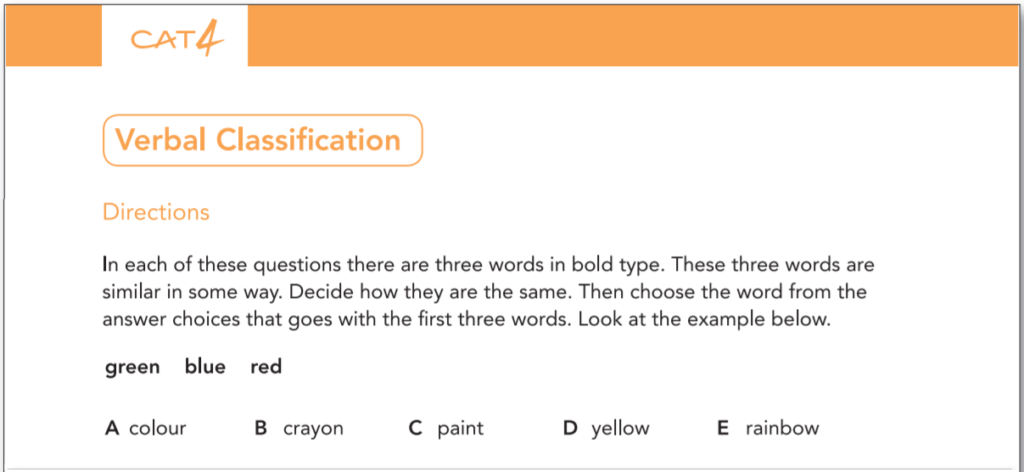Development of School Admission Tests in the UK and Ireland
CAT4 school entrance tests in the UK and Ireland have gradually evolved over the years in alignment with the development changes of the education system. A key driver has been to provide the best students with the best educational opportunities whatever their background. Entrance exams historically assessed academic subjects such as English, mathematics, and science to determine a student’s eligibility to attend a grammar or independent school. In recent times school have shifted to more holistic assessments to determine a student’s cognitive ability, critical thinking skills, and ultimately future potential. Educators have used these types of cognitive assessments to determine the dormant potential within a child which can be fulfilled with the right opportunity and nurturing environment.
Tests like the Cognitive Abilities Test (CAT4), assess the ability to think, and measure a child’s verbal, non-verbal, spatial, and quantitative reasoning. These areas are much more predictive of their future success at GCSE and A-Levels. Educational institutes have recognized that traditional exams are bias towards those who have a more nurturing school and home environment rather than a student’s actual aptitude.
Ireland has also taken a similar view towards more diagnostic cognitive assessments, helping to ensure students from all educational backgrounds have an equal opportunity. Entrance exams aim to assess both academic achievement with a broader understanding of students’ capabilities, supporting more informed and equitable admissions decisions which allow those who have ability to rise to the top.
CAT4 Development
Cognitive Ability testing was initially introduced in the UK, with the first versions of a CAT4 type test being used in the 1980s. Cognitive testing evolved over the years and various revisions and improvements introduced which have most recently culminated in one of the most popular cognitive tests used for school admissions – the CAT4.
The CAT4 eventually evolved to measure four keys areas which following significant research over the years are accurate at predicting future achievement particularly in GCSEs. The four skills areas measured by the CAT4 are: verbal reasoning, non-verbal reasoning, quantitative reasoning, and spatial ability. Understanding a child’s thinking and problem-solving skills may not always be a predictor to future success but it is a very good predictor of potential a child has.
Typical traditional testing primarily assesses subject-specific knowledge, such as mathematics or reading which is very dependent on the opportunities a child has had in the past – gone a good school and / or had stable supporting parents. Cognitive tests (CAT4) focus on underlying thinking skills that directly underpin a student’s capacity to learn and reason in any context. Understanding these cognitive abilities helps schools to provide focused support, and plan for more individualized instruction where students excel or require extra help.
CAT4 in the UK

The CAT4 is very widely adopted by many primary and secondary schools from the ages of 6 to 17. It helps to support the admissions process in grammar and private schools and also informs academic targets, helping teachers understand the needs of a particular cohort of students. The CAT4 also influences the ways students are grouped since by predicting future academic performance and current cognitive ability students with similar abilities can be grouped into higher sets which push them to achieve even more while less able children can be supported appropriately depending on their identified learning needs. Creating tailored learning plans catering to individual student profiles becomes much simpler using the results of the cognitive tests.
Some students struggle since English may not be their first language – the CAT4’s non-verbal and spatial components are particularly valuable for them since it is able to ascertain a child’s potential ability and for a those with specific learning difficulties, such as dyslexia, aoiding a teacher simply thinking a child doesn’t have the capacity. Taking a broader view on intelligence rather than simply subject specific academic performance has made CAT4 a popular tool for teacher’s to get the most out of their students. The following schools are ones which use the CAT4 test but its a good idea to check with the school you are interested in to make sure nothing has changed.
Example of Schools in England that Use the CAT4
| School Name | Location |
|---|---|
| Eton College | Windsor, Berkshire |
| Harrow School | Harrow, London |
| Winchester College | Winchester, Hampshire |
| St Paul’s School | London |
| Westminster School | London |
| Rugby School | Rugby, Warwickshire |
| Charterhouse School | Godalming, Surrey |
| Oakham School | Oakham, Rutland |
| Haileybury School | Hertford, Hertfordshire |
| Bedford School | Bedford, Bedfordshire |
Example of Schools in Wales that Use the CAT4
| School Name | Curriculum |
|---|---|
| Haberdashers’ Monmouth Schools | British |
| Rydal Penrhos School | British |
| St John’s College | British |
| Howell’s School | British |
| The Cathedral School Llandaff | British |
| Monmouth School for Girls | British |
| Rougemont School | British |
| St David’s College | British |
| Christ College Brecon | British |
| Llanishen High School | British |
Example of Schools in Scotland that Use the CAT4
| School Name | Location |
|---|---|
| Hutchesons’ Grammar School | Glasgow |
| George Heriot’s School | Edinburgh |
| St Aloysius’ College | Glasgow |
| Dollar Academy | Clackmannanshire |
| Glenalmond College | Perthshire |
| Fettes College | Edinburgh |
| Loretto School | East Lothian |
| Strathallan School | Perthshire |
| Merchiston Castle School | Edinburgh |
| St Leonards School | St Andrews |
Example of Schools in Northern Ireland that Use the CAT4
| School Name | Curriculum |
|---|---|
| Methodist College Belfast | British |
| Campbell College Belfast | British |
| Belfast Royal Academy | British |
| Friends’ School Lisburn | British |
| Sullivan Upper School | British |
| Wallace High School | British |
| Banbridge Academy | British |
| Portora Royal School | British |
| Lurgan College | British |
| Down High School | British |
CAT4 in Ireland

Introduction of the CAT4 in Ireland has followed a similar path to the UK with a large number of schools adopting it not just as part of their admissions process but also as part of their assessment framework. Ireland’s emphasis on individualized learning and inclusive education provides can be driven by cognitive abilities testing and the reporting helps teachers get an objective measure of student abilities – furthermore their may be a common thread in a particular cohort and thus teaching approaches can be modified accordingly – the post-COVID generation for instance may have some strengths and weaknesses which other generations did not. The following is a list of some of the schools in Ireland which use the CAT4 but double check with your school of choice to make sure this is still the case:
| School Name | Curriculum | Notes |
|---|---|---|
| St. Columba’s College | Irish (Transition Year) | CAT4 is used for Year 7 admissions. |
| The King’s Hospital School | Irish (Transition Year) | CAT4 is used for secondary school admissions. |
| Wesley College Dublin | Irish (Transition Year) | CAT4 is used for Year 7 admissions. |
| Alexandra College | Irish (Transition Year) | CAT4 is used for secondary school admissions. |
| Blackrock College | Irish (Transition Year) | CAT4 is used for Year 7 admissions. |
| Castleknock College | Irish (Transition Year) | CAT4 is used for secondary school admissions. |
| Mount Anville Secondary School | Irish (Transition Year) | CAT4 is used for Year 7 admissions. |
| Terenure College | Irish (Transition Year) | CAT4 is used for secondary school admissions. |
| Gonzaga College | Irish (Transition Year) | CAT4 is used for Year 7 admissions. |
| St. Andrew’s College | Irish (Transition Year) | CAT4 is used for secondary school admissions. |
Benefits and Challenges of the CAT4
The adoption of CAT4 in Ireland and the UK benefited both education systems providing teachers of both nations with a deeper understanding of student learning styles and helping inform schools with the data to determine class placement and program intervention. Parents can also benefit by understanding their child’s areas for development and support their education accordingly.
Challenges do exist with some critics arguing that the insights gained from tests like the CAT4 need to be used along with other tests – the 11 plus for instance uses a combination of subject knowledge and cognitive skills assessment. They argue over-reliance on cognitive tests may overshadow other areas of student development, such as creativity, emotional intelligence, and social skills.
Conclusions
The use of CAT4 in Ireland and the UK has impacted educational practices, offering an insight into the future potential of students. Understanding the cognitive reasoning level of a student helps teacher understand the capacity of a child to learn rather than simply recall information. Ultimately a holistic approach should be taken which considers other areas of development and growth which are just as important to our children’s future success and healthy contribution towards society.





